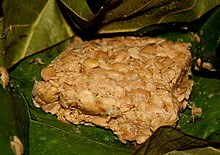Kinema
This article may require cleanup to meet Wikipedia's quality standards. The specific problem is: Wikification needed. (May 2017) |
 | |
| Place of origin | Limbuwan (present-day in Eastern Nepal, Northern Sikkim, India, and Western Bhutan) |
|---|---|
| Region or state | Nepal, Bhutan, Sikkim, India, Darjeeling, India |
| Created by | Limbus |
| Main ingredients | Soybean fermented by Lactobacillus |
Kinema (Nepali: किनेमा) is an indigenous fermented soybean food prepared mostly by the Limbus of the Eastern Himalayan regions, what is now Eastern Nepal, and Darjeeling and Sikkim regions of India.[1] The word 'kinema' is believed to be derived from the tribal Limbu language 'kinambaa', where 'ki' means fermented and 'nambaa' means flavour.[2] It is a traditional food of the Kirati people throughout Eastern Nepal, and Darjeeling and Sikkim regions of India.[3]
The slimy, odorous product of fermentation is traditionally prepared into a soup that is consumed with rice, but can also be turned into a savoury dip or a pungent side dish to accompany rice or bread. Kinema is traditionally prepared at home, but now it is sold in local markets and even retailed online as a dried product. Kinema is considered a healthy food because fermentation breaks down complex proteins into easily digestible amino acids. It is very similar to Japanese nattō and akhuni of Northeast India.
See also
References
- ^ P.33 Handbook of Indigenous Foods Involving Alkaline Fermentation By Prabir K. Sarkar, M.J. Robert Nout, CRC Press, 23 Jul 2014
- ^ P.367 History of Natto and Its Relatives (1405-2012) By William Shurtleff, Akiko Aoyagi, Soyinfo Center, 2012 - Fermented soyfoods
- ^ P.367 History of Natto and Its Relatives (1405-2012) By William Shurtleff, Akiko Aoyagi, Soyinfo Center, 2012 - Fermented soyfoods
